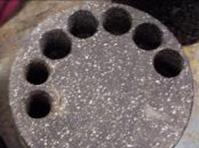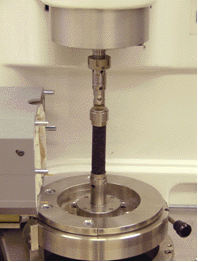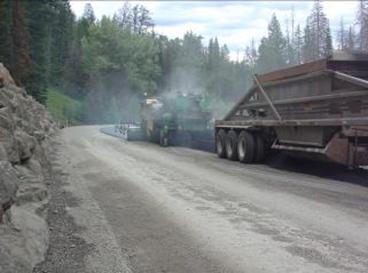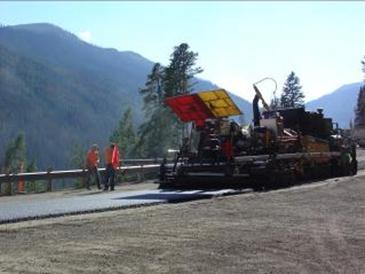|
ASPHALT RESEARCH CONSORTIUM |
|
An FHWA Research Program Comprising Western Research Institute, Texas A&M University, University of Wisconsin-Madison, University of Nevada-Reno and Advanced Asphalt Technologies. |
|
Asphalt Research Correspondent |
|
This issue highlights the work of Asphalt Research Consortium members Texas A&M University and Western Research Institute. Overall objectives, strategic plan, and work plans of the Asphalt Research Consortium are available on our website at: www.arc.unr.edu. |
|
Vol 2 Issue 2 Oct 2008 |
|
Above Image: Paving a comparative performance evaluation section on U.S. 77 in Kansas in 2002. |
|
Members of the Western Research Institute (WRI) research team are involved in two major activities: 1.WRI and state and local partners are conducting comparative studies of the performance of different construction materials in highway pavement sections under different climatic conditions. 2.The team is breaking ground on a multi-scale, multi-physics chemo-mechanical asphalt binder microstructure model with the goal of developing a virtual asphalt concrete testing laboratory. |
|
To remove your name from our mailing list, please click here. Questions or comments? E-mail us at psebaaly@unr.edu or call 775-784-6565. |
|
The Asphalt Research Consortium (ARC) team at Texas A&M University (TAMU) is investigating three broad QUESTIONS. 1. What critical and fundamental material and mixture properties influence mixture performance? TAMU is making significant progress in identifying these properties. 2. How can we characterize fundamental material properties and the damage evolution in materials and mixtures? TAMU is developing test methods and analytical tools. 3. How do we predict the response of asphalt mixtures at different length scales? TAMU is developing models that integrate these fundamental material properties with boundary conditions. |
|
The most common method to determine the fatigue and moisture damage resistance of asphalt mixtures is to perform mechanical tests under controlled laboratory conditions on mixture specimens…
PRO An advantage of this approach is that candidate mixtures can be ranked on the basis of their performance using a relatively simple laboratory test. Another is that it takes into account the combined effect of material and mixture properties on performance. CON There are two major limitations of this approach. First, it does not provide information that can be used to explain why certain mixtures perform better than others. This limits the ability of the materials design engineer to make cost-effective decisions and improve the performance of poorly performing mixtures. Second, the evolution of damage from some of the traditional fatigue tests is dependent on the test conditions.
To address these shortcomings, the Texas A&M team proposes three scales of analysis. If each scale is properly analyzed sequentially, then the “weak-link” can be identified and corrections to the mixture can be made. Scale 1, Constituent materials (e.g. binder, aggregate, and fines). Analysis at this scale helps identify the contribution of each of the materials to the damage evolution. Scale 2, Fine aggregate matrix (e.g. aggregate smaller than 1-mm, the mineral filler, and the asphalt binder.) Analysis at this scale helps identify the material interactions that contribute to damage. Scale 3, Full asphalt mixture Analysis at this scale helps identify the role of coarse aggregate properties and mixture microstructure in damage to the mix.
Dynamic Mechanical Analysis of Fine Aggregate Matrix The research team developed a test method to evaluate the fatigue properties of fine aggregate matrix using the Dynamic Mechanical Analyzer (DMA). The DMA testing is used with the crack growth index developed at Texas A&M to define the fatigue cracking characteristics of different fine aggregate matrices. Click to read more.
Diffusion of Moisture in Asphalt Binders One of the fundamental material properties that influence the rate of moisture damage in asphalt mixtures is the rate of moisture diffusion through asphalt binders. The Texas A&M research team has developed a test method using spectroscopic techniques to determine the diffusivity of water through thin films of asphalt binders.
Healing Self-healing in asphalt binders during rest periods causes at minimum a reduction in the rate of damage and in some cases a reversal of crack growth. In all cases, healing results in an extension of the life of the asphalt mixture and the pavement. Recently, the ARC developed a model that defines the healing process in asphalt binders. The model is a convolution of two processes that represent the two fundamental actions that cause self-healing: wetting of crack surfaces and strength gain across the wetted interface. Click to read more.
|

|
Researchers at Texas A&M test fine aggregate matrix using dynamic mechanical analysis (top) to gain insight into damage evolution. The specimen preparation procedure (bottom) yields approximately 15 test specimens from a single SuperPave gyratory compactor specimen. This reduces the prep time and provides enough test replicates for fatigue tests.
|

|
A Review of WRI’s Comparative Performance Sections |
|
What are comparative pavement performance sections? The WRI team works with state DOTs and other agencies to design and construct comparative pavement sections for the purpose of studying pavement performance. Different construction materials (to date, these have been mostly different asphalt crude oils) are laid down using the same construction techniques in a location receiving the same traffic loading and environmental exposure. WRI than monitors the sites annually using FHWA-LTPP distress monitoring methods. Six sites have been constructed in Arizona, Kansas, Minnesota, Nevada, and Wyoming. When a comparative pavement performance section is constructed, samples of all materials are collected for later use as new performance prediction tests and methods are developed. Core samples are taken from the pavements immediately after construction and after the pavement is in service to assess the changes that occur with traffic and environmental exposure. The sites provide a direct connection between performance variation and material property variation, and most of the sites are showing differences in performance of the materials. Asphalt binder is a molecularly complex and variable material; researchers use the sites and the site materials to investigate the differences between the original materials and the pavement over time and to evaluate what characteristics of asphalt are important to good performance. Asphalt Research Consortium (ARC) researchers also use the materials, data, and performance evaluations from the material comparison sites to help validate and calibrate performance predictive test methods and models that are being developed in the Moisture Damage, Fatigue, and Engineered Materials program areas. ARC
|
|
Welcome to Yellowstone!
The most recent site was constructed in cooperation with FHWA Western Federal Lands in September 2007 near the east entrance to Yellowstone National Park on U. S. Highway 14-16-20. This second Wyoming site was built with two warm-mix asphalt mixes using different additives and a control hot-mix asphalt. The Yellowstone site was recently monitored after the first year of service, and all the materials are performing well. A unique aspect of the site is that its pavement sections are under snow cover from approximately November to May each year, and only over-snow vehicles use the road then. The WRI team and other ARC researchers are studying these sections to assess the difference in performance that may be caused by the warm-mix additives and to evaluate the potential differences in pavement aging that may result from using a lower temperature to produce and place the asphalt mix. |
|
Ambient air emissions around the paving operation were noticeably different between the control hot-mix asphalt (above) and the warm-mix asphalts (left). |





|
Predictive models of material properties and reliability are routinely used in the pharmaceutical, metals, and semiconductor industries. Quantitative theory based on fundamental materials science has been successfully applied to many materials. Why can’t we do this with asphaltic concrete? One answer might be that asphaltic concrete is a complex material comprising several different “types” of components, including the asphalt binder or “glue” (i.e., heavy residual distillate from crude oil), the aggregate (typically limestone or granite), complex binder–aggregate interactions, and any number of chemical additives. What’s more, as temperatures change, the binder undergoes chemical reactions and physical phase changes at many length scales, down to the nanometer scale. Aggregate packed with binder ranges from a few tens of micrometers to approximately 15 mm. Traffic loading of the pavement slab and environmental conditions (seasonal changes in temperature and the impact of moisture) are random and difficult to characterize but contribute significantly to pavement failure. The only way to handle the simultaneous chemistry and microstructure development of the binder as it interacts with the aggregate and additives/modifiers over many length scales is with a computer model of the whole material system that accounts for fundamental chemistry, physics, and mechanics of the asphalt binder molecular composition interacting with the aggregate mineralogy. Introducing a Vision for a Virtual Asphalt Concrete Testing Laboratory To realize the vision of a fundamental predictive model of asphalt concrete properties requires a multiscale, multiphysics approach involving the cooperative involvement of many research entities. In short, a chemo-mechanical model for asphaltic concrete is a tall order. The Asphalt Research Consortium is taking it on... (Includes Historical Notes and References.)
|